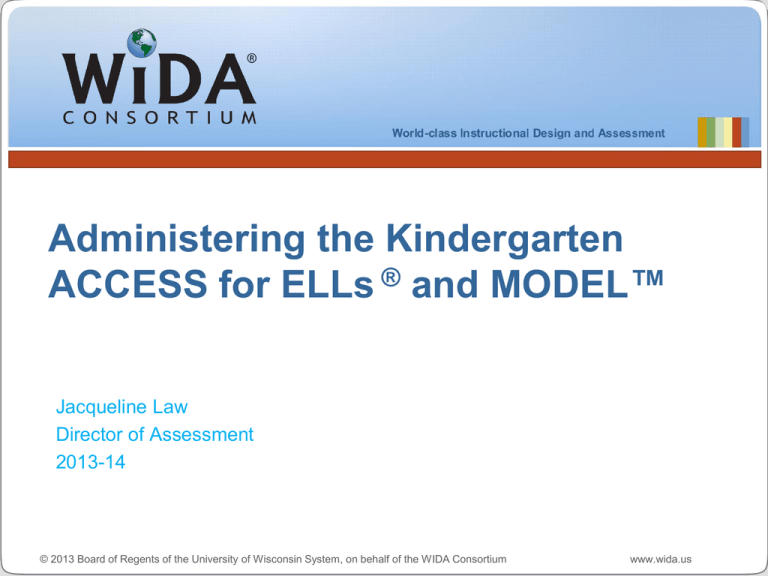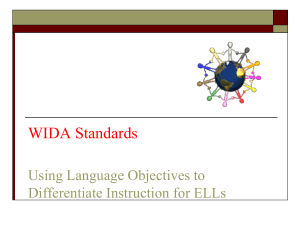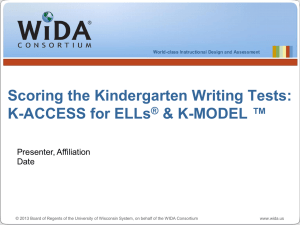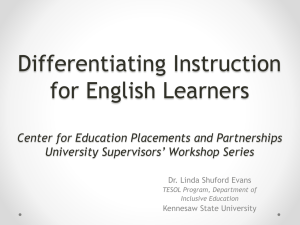Administering Kindergarten ACCESS for ELLs
advertisement

Administering the Kindergarten ACCESS for ELLs ® and MODEL™ Jacqueline Law Director of Assessment 2013-14 © 2013 Board of Regents of the University of Wisconsin System, on behalf of the WIDA Consortium www.wida.us SECURE & CONFIDENTIAL DO NOT POST THESE MATERIALS TO PUBLIC WEBSITES OR FORUMS. Contains secure and confidential information. WIDA Consortium / CAL / MetriTech Administering the WIDA Kindergarten Tests 2 Training Objectives To train test administrators to administer the Kindergarten ACCESS for ELLs and WIDA MODEL for Kindergarten Tests. To understand the organization, layout, and scripting of the tests. To learn the procedures for administering and reliably scoring the tests. WIDA Consortium / CAL / MetriTech Administering the WIDA Kindergarten Tests 3 Purpose of the Kindergarten Tests Assesses students’ academic English language proficiency. Academic language is the vocabulary, grammatical structures and discourse required in learning the academic content of school subjects; aspects of language strongly associated with literacy development and achievement. WIDA Consortium / CAL / MetriTech Administering the WIDA Kindergarten Tests 4 Orientation to the PreK-K ELD* Standards WIDA Consortium / CAL / MetriTech Administering the WIDA Kindergarten Tests 5 Pre-K/K ELD Standards WIDA Consortium / CAL / MetriTech Administering the WIDA Kindergarten Tests 6 A Strand of MPIs ELD Standard 4: The Language of Science WIDA Consortium / CAL / MetriTech Administering the WIDA Kindergarten Tests 7 Kindergarten Test Design and Administration WIDA Consortium / CAL / MetriTech Administering the WIDA Kindergarten Tests 8 Kindergarten Test Design Aligned to PreK-K Standards The test is thematically integrated within two stories: A narrative story An expository story All domains (listening, speaking, reading, writing) are tested within each story. All domains are individually administered and adaptive so the student will start sections at appropriate levels and stop at his or her “ceiling.” All components are scored by the Test Administrator (TA) during test administration. In its entirety, the test takes an average of 45 minutes. WIDA Consortium / CAL / MetriTech Administering the WIDA Kindergarten Tests 9 Unique Features of the Tests Manipulatives Cards Student Activity Board Thematic Test questions center around two themes. All four domains are tested in each theme. Interactive Writing Experience The student has an opportunity to produce whatever he/she is able. WIDA Consortium / CAL / MetriTech Administering the WIDA Kindergarten Tests 10 Narrative vs. Expository Narrative: Appropriate graphics Main characters are animals Description Rhyme, Rhythm Reminiscent of quality children’s literature 3rd person Fictional WIDA Consortium / CAL / MetriTech Expository: Time sequence Non-fiction Involves "doing“ or “how to” Realistic or believable actions with people as main characters Story sequence between steps, logical organization Relate to events in student’s life Administering the WIDA Kindergarten Tests 11 Test Structure The test administrator (TA) reads the Narrative storybook, then administers: A. Listening & Speaking Tests (together) B. Writing Experience C. Reading Test The TA will then administer the following sections using the Expository activity board and cards: D. Listening & Speaking Tests (together) E. Writing Experience (starting point is based on Writing Experience score from Part B) F. Reading Test (starting point based on Reading score from Part C) WIDA Consortium / CAL / MetriTech Administering the WIDA Kindergarten Tests 12 Kindergarten Test: Structure Listening and Speaking Writing Reading Listening and Speaking Writing Reading WIDA Consortium / CAL / MetriTech Move through the Levels of each part until student reaches his/her ceiling Part E (Writing) and Part F (Reading) Starting points are determined by performance on prior Writing and Reading tasks. Administering the WIDA Kindergarten Tests 13 Testing Materials (1 of 2) The Kindergarten Student Story Booklet contains: Pictures and story for the Narrative section of the test (resembling authentic children’s literature) Graphic organizers related to designated sections of the test Student Story Booklet Kindergarten Student Response Booklet contains: Answer key for Listening & Reading items Space to record and tally student responses Criteria for moving on/winding down Student writing and teacher transcription of student writing WIDA Consortium / CAL / MetriTech Student Response Booklet Administering the WIDA Kindergarten Tests 14 Testing Materials (2 of 2) Kindergarten Test Administrator Script contains: Moving on/winding down script Expect boxes to assist with scoring students’ speaking responses Kindergarten Student Activity Board Test Administrator Script Kindergarten Cards & Card Pouch Booklet Cards and Card Pouch Booklet WIDA Consortium / CAL / MetriTech Student Activity Board Administering the WIDA Kindergarten Tests 15 General Test Administration Procedures Follow the script EXACTLY. Read aloud everything in black bold and blue bold print. Student responses must be recorded and scored IMMEDIATELY after each level is complete (e.g. after A3). You must administer and score all items in any one level of a Part before making a determination about whether to continue to the next level or to stop that Part. Kindergarteners may need breaks during the test administration. Stretch breaks may be taken between each section of the test (e.g. after Listening/Speaking, before Writing) The test may be administered in two sessions with a break of no more than 2 school days between Parts C (Narrative) & D (Expository) WIDA Consortium / CAL / MetriTech Administering the WIDA Kindergarten Tests 16 Symbols in the Script Card used for modeling Gray box indicates that cards should be face down WIDA Consortium / CAL / MetriTech Keep all cards in hand Administering the WIDA Kindergarten Tests 17 Preparing for Test Administration Familiarize yourself with the Test Administrator Script for each portion of the Kindergarten Test prior to administering the test. It is recommended to practice with a colleague before you administer to a student. You will need 2 sharpened pencils: one for you and one for the student. Testing should occur in a quiet room. Administer the test to the student using rectangular (preferable) or circular table. Place yourself at a right angle to the student, rather than across from or next to the student. WIDA Consortium / CAL / MetriTech Administering the WIDA Kindergarten Tests 18 About Accommodations Remember, test accommodations are only available to students with disabilities (IEP or 504 Plan in place). Check with your school assessment coordinator if you have questions about accommodations. The Test Administration Manual contains definitions to explain how to use the accommodations, and coding information for the accommodations section. WIDA Consortium / CAL / MetriTech Administering the WIDA Kindergarten Tests 19 Parts A ― C: Narrative Administration Information WIDA Consortium / CAL / MetriTech Administering the WIDA Kindergarten Tests 20 Part A: Listening & Speaking Format: Both domains are administered together by level. The Listening items for one level are administered, then the Speaking items for that same level are administered. Directions: Read the entire narrative story first, then go to the beginning of Part A (level A1) to administer Listening and Speaking. Move through the levels, A1 to A5, based on student’s responses. Guidelines: Follow the Test Administration Script exactly, including pauses. Keep the test going at a steady pace. Scoring: After the student answers all items in a level, complete the score sheet in the Student Response Booklet. WIDA Consortium / CAL / MetriTech Administering the WIDA Kindergarten Tests 21 Listening Items Listening items prompt the student to point to something in a picture, or point to and/or move a card. Do NOT read a Listening item more than one time.* Scoring: Listening items are marked correct or incorrect. WIDA Consortium / CAL / MetriTech Administering the WIDA Kindergarten Tests 22 Speaking Items Speaking items prompt the student to talk about the pictures and the story. Scoring: There is guidance as to what to look for in a student response, found in the “Expect” box. Follow these guidelines to determine if the student meets or does not meet the task-level expectations. NOTE: These are based on the WIDA Speaking Rubric. Refer to the rubric if you have questions. WIDA Consortium / CAL / MetriTech Administering the WIDA Kindergarten Tests 23 Task Level Expectations Every task is based on a set of expectations for what the response should look like. The TA rates each task holistically, considering the response to all questions in the task. Scoring expectations are based on: Linguistic Complexity: Expectations of the quantity and organization of the student’s verbal response Vocabulary Usage: Expectations of the student’s use of appropriate vocabulary for grade level and proficiency level; refers to language quality Language Control: Expectations of the student’s control of English grammar, word choice in context, and the English sound system; refers to language quality WIDA Consortium / CAL / MetriTech Administering the WIDA Kindergarten Tests 24 Meets vs. Approaches Speaking Test Scoring Scale Meets Approaches Meets all task level expectations in quantity and quality Approaches task level expectations, but falls short in quantity and/or quality “Meets” is highlighted on the scale to emphasize that Meets is the expected score. Tasks are designed to elicit speech that will meet all expectations of the proficiency level it targets. WIDA Consortium / CAL / MetriTech Administering the WIDA Kindergarten Tests 25 Scoring Rules The TA must score the item immediately after the student responds to the last question in a task. If unsure whether to score a response Meets or Approaches, the “?” (question mark) box can be marked. Then administer the next task. If the response to the next task scores Meets, go back and rate the previous task (the one with ? marked) Meets. If the response to that next task scores Approaches, go back and rate the previous task Approaches. Note: The last task on a Part may not be scored with a “?”. The rating represents the student’s performance on the complete task, not on individual questions within the task. WIDA Consortium / CAL / MetriTech Administering the WIDA Kindergarten Tests 26 Speaking Rubric Speaking Rubric WIDA Consortium / CAL / MetriTech Administering the WIDA Kindergarten Tests 27 Part A Listening Script Indicates the Part and Level: This is Part A, Level 1 Orientation to the upcoming task Graphic student sees in the Student Story Booklet Unscored sample question A1 Listening Items WIDA Consortium / CAL / MetriTech Administering the WIDA Kindergarten Tests 28 Part A Speaking Script A1 Speaking Items What to look for in student response WIDA Consortium / CAL / MetriTech Administering the WIDA Kindergarten Tests 29 Part A: Recording Answers 1) Fill in the correct or incorrect bubble for each level. 2) Fill in Meets, Approaches, or ?. WIDA Consortium / CAL / MetriTech 3) Determine if you are to move on in Part A, or go to Part B. 4) Stopped Here: fill in if this is the last level administered. Administering the WIDA Kindergarten Tests 30 Test Navigation There is a “Moving On” section of the script, which indicates what you are to do next after scoring a level. You are always moving ahead in the test, either to the next level in the same Part, or to the next Part of the test if the child does not meet expectations. Only after Part F do you end the test. WIDA Consortium / CAL / MetriTech Administering the WIDA Kindergarten Tests 31 Part B: Writing Experience Format: There are two tasks in this Part of the Writing Test, assessing five levels. First, the student writes his/her name as a screening task. If done successfully, the student proceeds to the Writing Experience. In the Writing Experience, the script prompts the student to talk about something from the story, then write it. If the student is struggling, there are prompts to scaffold the student to write words and sounds. Scoring: Based on the PreK/K Writing Rubric WIDA Consortium / CAL / MetriTech Administering the WIDA Kindergarten Tests 32 Part B: Writing Script Orientation Item What’s next? WIDA Consortium / CAL / MetriTech Administering the WIDA Kindergarten Tests 33 Part B: Student Response Booklet Left page (Teacher’s page) Right page (Student’s Page) Transcribe what the student says he/she wrote in the box. WIDA Consortium / CAL / MetriTech Administering the WIDA Kindergarten Tests 34 Scoring in Writing The student writes in the Student Response Booklet. After the student writes, the TA transcribes what the student says he/she wrote. Score the writing as “High,” “Mid,” or “Low” immediately and check off the box at the bottom of Part B in the Student Response Booklet. Assign the writing a score of 1-6 using the Writing Rubric after the student completes the entire test. WIDA Consortium / CAL / MetriTech Administering the WIDA Kindergarten Tests 35 High, Mid, Low The Expect box for writing contains the criteria to determine the starting point in Part E (Writing). WIDA Consortium / CAL / MetriTech Administering the WIDA Kindergarten Tests 36 K Writing Rubric (1 of 3) Writing Rubric of the WIDA Consortium Grades Pre K-K Level Linguistic Complexity •Text presents one clear example of a successful attempt at producing related, connected English phrases and sentences 6 Evidence: Complete “Story” •At least two clear sentences are present •“Words” are clearly recognizable and •A logical sequence or relationship between contain beginning, middle and ending phrases and sentences is present sounds (in longer words) •Each phrase or sentence contains at least two “words” •Text contains at least one clear example of a successful attempt at producing at least two related or connected English phrases or sentences 5 Evidence: “Story” Vocabulary Usage •“Words” go beyond memorized, highfrequency vocabulary, though some sight words and easily decodable words may be present and written accurately Language Control •Invented spelling and/or lack of mechanics may impede full comprehensibility of the text •Inventive spelling closely approximates standard spelling •Evidence of capitalization and punctuation may be present •No clear observable influence of native language is present •“Words” go beyond memorized, highfrequency vocabulary •Invented spelling and/or lack of mechanics may impede comprehensibility of the text •Evidence of word boundaries is present •At least one clear sentence is present •“Words” are generally recognizable and contain attempts at beginning, middle and ending sounds (in longer words) •A logical or sequential word order within phrases or sentences is present •All key “words” in the related or connected phrases or sentences are attempted •Observable influence of native language may be present •Each phrase or sentence contains at least two “words” WIDA Consortium / CAL / MetriTech Administering the WIDA Kindergarten Tests 37 Part C: Reading Format: There are five levels of tasks on the Reading Test. Tasks include matching cards, categorizing pictures, and pointing to a picture. Some of the initial tasks assess pre-literacy skills. Scoring: Reading items are each scored correct or incorrect. Based on how many tasks the student correctly completed, score the student’s performance as “High,” “Mid,” or “Low” and record in Part F in the Student Response Booklet. This will determine the starting point in the next Part of the Reading test. WIDA Consortium / CAL / MetriTech Administering the WIDA Kindergarten Tests 39 Part C: Reading Script Symbol indicating for the TA to keep cards in hand Unscored Model of task WIDA Consortium / CAL / MetriTech Thumbnail of what the student sees in Student Story Booklet Thumbnails of pictures on the cards C2 Items Administering the WIDA Kindergarten Tests 40 Part C: Recording Answers Fill in the correct or incorrect bubble for each question. Determine if you will move on to the next Level within Part C, or go to Part D. WIDA Consortium / CAL / MetriTech Stopped Here: fill in if this is the last level administered. Administering the WIDA Kindergarten Tests 41 Parts D — F Expository Administration Directions WIDA Consortium / CAL / MetriTech Administering the WIDA Kindergarten Tests 42 Part D: Listening and Speaking Tests Listening & Speaking like Part A Based on the Activity Board Open and close panels as directed Follow the script exactly Begin at level D1, and administer Part D until student reaches his/her ceiling Scoring rules for Part D are the same as for Part A WIDA Consortium / CAL / MetriTech Administering the WIDA Kindergarten Tests 43 Activity Board WIDA Consortium / CAL / MetriTech Administering the WIDA Kindergarten Tests 44 Part E: Writing Leveled writing tasks Entrance point based on student’s performance on Part B. Mark the student’s starting point in Part E under the Started Here column If “High” start with E4/5 (Writing Experience) If “Mid” start with E3 (Leveled Tasks – Beginning & Ending Sounds) If “Low” start with E1 (Leveled Tasks – Tracing & Copying) WIDA Consortium / CAL / MetriTech Administering the WIDA Kindergarten Tests 45 Part E: Writing If a student is unable to complete the task or scores only one item correctly, the test administrator will mark Stopped Here, indicating that the student is done with this Writing section. WIDA Consortium / CAL / MetriTech Administering the WIDA Kindergarten Tests 46 Part E: Script Unscored Models WIDA Consortium / CAL / MetriTech Administering the WIDA Kindergarten Tests 47 Part E: Student Response Booklet Right Page Left Page Teacher model for beginning sound Teacher model for end sound Student writes in the box WIDA Consortium / CAL / MetriTech Administering the WIDA Kindergarten Tests 48 Part E: Scoring Guidance E1 – E3 Leveled Tasks : Scored as Correct or Incorrect. If the student completes a level successfully (following the Stop If criteria), move on to the next level. E4/5 Writing Experience Task: Rated using the PreKK Writing Rubric. The test administrator assigns the writing a score of 16 using the Writing Rubric after the student completes the entire test. WIDA Consortium / CAL / MetriTech Administering the WIDA Kindergarten Tests 49 Part F: Reading There are 5 levels of Reading tasks in Part F. Entrance point based on student’s performance on Part C. Mark the student’s starting point in Part F under the Started Here column If “High” start with F4 (reading short phrases) If “Mid” start with F3 (reading words) If “Low” start with F1 (pre-literacy task) Scoring Part F is the same as scoring Part C. Both F1 and C1 require you to MOVE ON, regardless of the number of correct answers. WIDA Consortium / CAL / MetriTech Administering the WIDA Kindergarten Tests 50 Positive Reinforcement Be sure you end the test with something the student can do so that students leave with a positive feeling about the experience. In Listening Parts: If the student clearly does not understand the listening task, you may repeat the model. If the student still doesn’t understand, continue modeling with the other items, but score them as incorrect. In Speaking Parts: If the student says “I don’t know” you may assist him/her, but mark the answer “Approaches.” In Writing Parts: If the student cannot write sentences, prompt him/her to write single words or letters. In Reading Parts: If the student can’t read words or sentences encourage him/her to identify a sound or a picture he/she recognizes. WIDA Consortium / CAL / MetriTech Administering the WIDA Kindergarten Tests 51 What are some challenges of administering a test like this to Kindergarten age students? WIDA Consortium / CAL / MetriTech Administering the WIDA Kindergarten Tests 52 Challenge: Behavior of Kindergarteners Kindergarten students are easily distracted Extra effort should be made to ensure the testing area is quiet and away from student traffic. Although TAs should be ready to redirect students to the task, the scripts will include advice for extra prompting. Kindergarten students need more stretch breaks: this should be at the discretion of the TA when he/she senses fatigue or distraction. WIDA Consortium / CAL / MetriTech Administering the WIDA Kindergarten Tests 53 Challenge: Literacy of Young Learners All Kindergarteners are developing literacy skills; the test will therefore include some pre-reading and prewriting tasks. Additionally, at this developmental level, writing and reading skills are very intertwined, yet NCLB requires testing these as discrete skills. The existing WIDA Writing Rubric has been modified for the Kindergarten level to reflect rules for “inventive spelling” and task level expectations. WIDA Consortium / CAL / MetriTech Administering the WIDA Kindergarten Tests 54 Challenge: Maximizing Student Performance Take time before test administration to establish rapport with the student. Experience with young students is recommended for TAs for the Kindergarten test. Make extra effort to put the student at ease: Small talk on the way to the testing area Say, “We’re going to play some games/read a book” Establish age/birthday Talk about what they were doing in class, what they had for lunch, who is in their family, their favorite food, etc. WIDA Consortium / CAL / MetriTech Administering the WIDA Kindergarten Tests 55 Challenge: Training Test Administrators Given the requirements of the scoring and the quantity of materials used in the test, sufficient training must be made available to test administrators. Additional training resources: Kindergarten Test Administration Training Video Complete Test Administration Scoring and adaptivity instructions Online Training Course at www.wida.us Speaking sound files Scored writing samples Kindergarten Test Administrator Manual Face-to-face training in your state or district Practice giving a test to a colleague WIDA Consortium / CAL / MetriTech Administering the WIDA Kindergarten Tests 56






